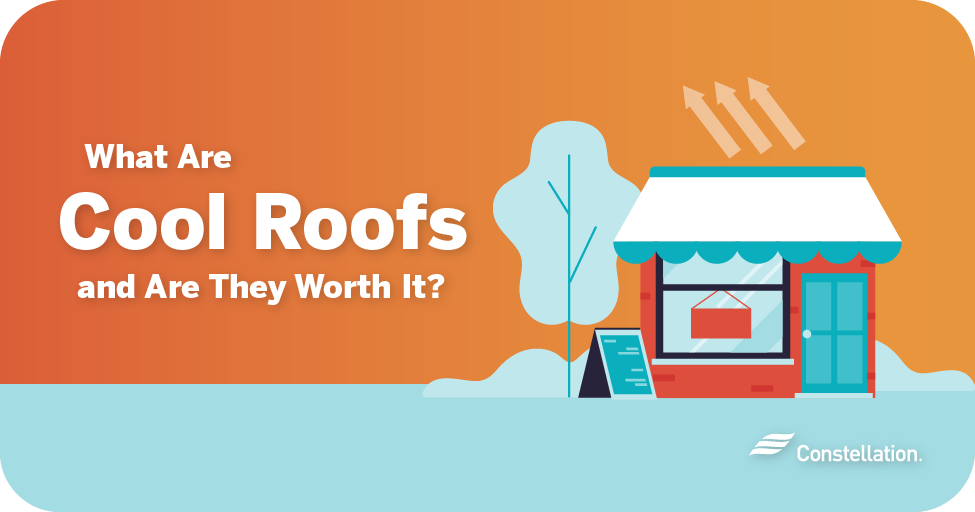
- Category:
Small Business Energy Savings -
Last updated:
July 6, 2022
What Are Cool Roofs and Are They Worth It?
If you own a small business, it’s important to consider how your building’s roof impacts your energy consumption. The wrong type of roofing can lead to issues in the summer, forcing your HVAC system to work overtime and potentially leaving your employees and customers feeling hot and uncomfortable.
Cool roofs can help combat rising temperatures in hot climates, offering small businesses an opportunity to save on air-conditioning costs while ensuring a cool work environment.
- How do cool roofs work?
- Types of cool roofs
- Benefits and drawbacks of cool roofs
- What to consider when choosing a cool roof
- How Constellation uses cool roofing technology
- Are cool roofs worth it for small businesses?
How does a cool roof work?
Cool roofs are designed to reflect sunlight while absorbing less heat. Compared to traditional roofs, a cool roof has a high albedo, or solar reflectance. This means that cool roofs have a higher ability to reflect the sun’s rays, and thus save more energy than traditional roofing options.
For example, In hot climates, traditional roofs in the contiguous United States can reach temperatures of 150 to 185 degrees Fahrenheit. A cool reflective roof stays 50 to 60 degrees cooler when exposed to the same summer heat and direct sunlight.
Cool roofing systems also have high thermal emittance, which is the ability to radiate absorbed heat back into the air and away from your business. Solar reflectance and thermal emittance are the two factors used to calculate a roof’s Solar Reflective Index, or SRI. SRI ratings are given to each type of roof and have a range of 0-100, with higher numbers indicating a greater level of efficiency.
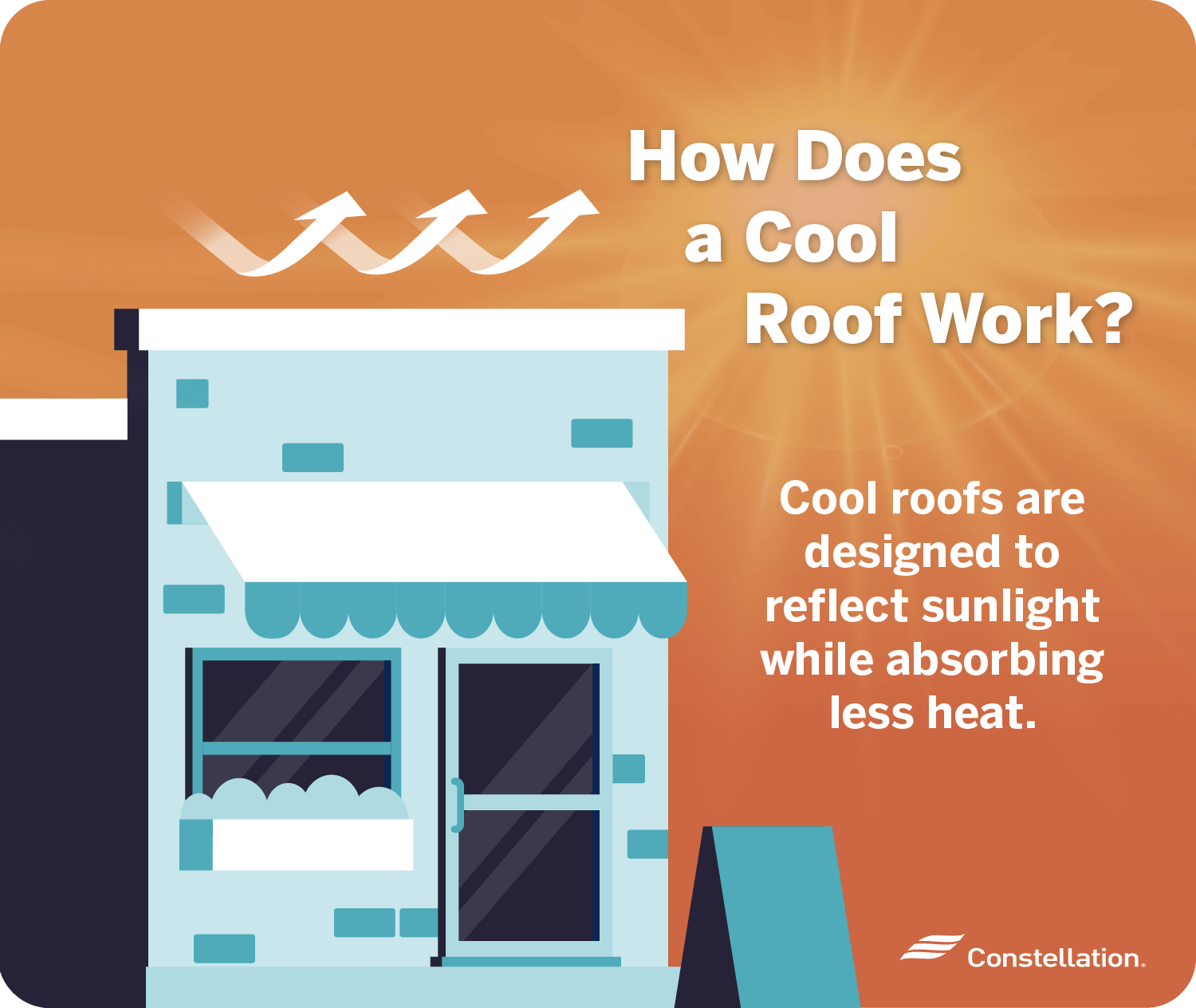
The three main types of cool roofs
Small business owners have a wide selection of cool roofs to choose from. The type of cool roof you should install largely depends on the size and structure of your building, as well as the slope of your roof. There are also some financial aspects worth taking into consideration. Before shopping around, it helps to have an idea of what your options are and the advantages each one offers.
The three main types of cool roofs include:
- Roofs made from naturally cool materials. Some roofing materials, such as metal and lightly-colored shingles and tiles, have a high SRI rating and are naturally energy-efficient.
- Roofs coated with a solar reflective coating. Depending on the type of roof your business has, you may be able to add a solar reflective coating to it. This option is often cheaper than replacing a roof and can offer many of the same energy-saving benefits.
- Green roofs. Green roofs are becoming increasingly popular choices for business owners, helping to both promote sustainability and offset energy costs.
The benefits and disadvantages of cool roofs
Cool roofs can be an excellent choice for keeping your business cool in the summer or year round in hot climates. They’re also effective at helping small business owners cut down on their business’s energy consumption. However, you may be wondering about the potential drawbacks that come with owning a cool roof.
Before deciding which type of roof is best for your business, it’s important to consider all the pros and cons of cool roofs, as well as how they could affect your business operations.
Benefits of cool roofs
Cool roofs have many benefits, from lowering indoor temperatures and improving air quality to reducing cooling costs and greenhouse gas emissions:
- Decreases indoor temperatures. Cool roofs reflect sunlight and radiate heat outward, which helps create cooler indoor environments and maintain an ideal office temperature.
- Lowers cooling costs. Cool roofs reduce the demand for air-conditioning, which can help lower your small business electricity bill and potentially prolong the life cycle of cooling equipment.
- Reduces greenhouse gas emissions. By ensuring your business’s cooling systems consume less energy, your small business will help decrease carbon emissions.
- Improves air quality. Cool roofs help prevent ground-level ozone from forming, as well as reduce smog.
- Extends your roof’s lifespan. Reflecting ultraviolet rays lowers roof temperatures, thus decreasing roof weathering and potentially increasing your roof’s life span.
Disadvantages of cool roofs
You may be able to offset some cool roof disadvantages by your choice of cool roofing system or by adapting other aspects of your building’s HVAC system. However, it’s still worthwhile to be aware of the potential cons of cool roofs:
- High retrofitting costs. Converting an existing roof can become expensive, especially when you include repair work, recoating, and cleaning costs.
- Potential for algae or mold growth. Mold and algae growth may occur when a cool roof is installed in a warm, humid location, although chemical treatments can help reduce such growth.
- Increases condensation. Cool roofs run the risk of increasing condensation, especially in hot, humid climates which may end up leading to water damage.
- Increases winter heating demand. The same reflective and thermal emittance features that make cool roofs so good at controlling temperatures in the summer can lead to increased heating needs in the winter.
Factors to consider when installing cool roofs
When determining which cool roofing color and material is best for your business’s needs, try taking the following factors into consideration:
1. Color choices for cool roofs
The color of your roof is one of the factors that can influence your small business energy costs. Traditional roofing is typically dark-colored or black, which leads to increased heat absorption. That said, there are energy-saving benefits to choosing a white roof or painting your current roof white. White roofs have a higher albedo and reflect more heat, which helps keep your small business cooler.
When you compare a white reflective roof with a gray roof, the differences become clear. A white roof reflects 80 percent of incoming sunlight compared to a gray roof, which reflects only 20 percent. The difference means the white roof will stay approximately 55 degrees Fahrenheit cooler than its gray counterpart.
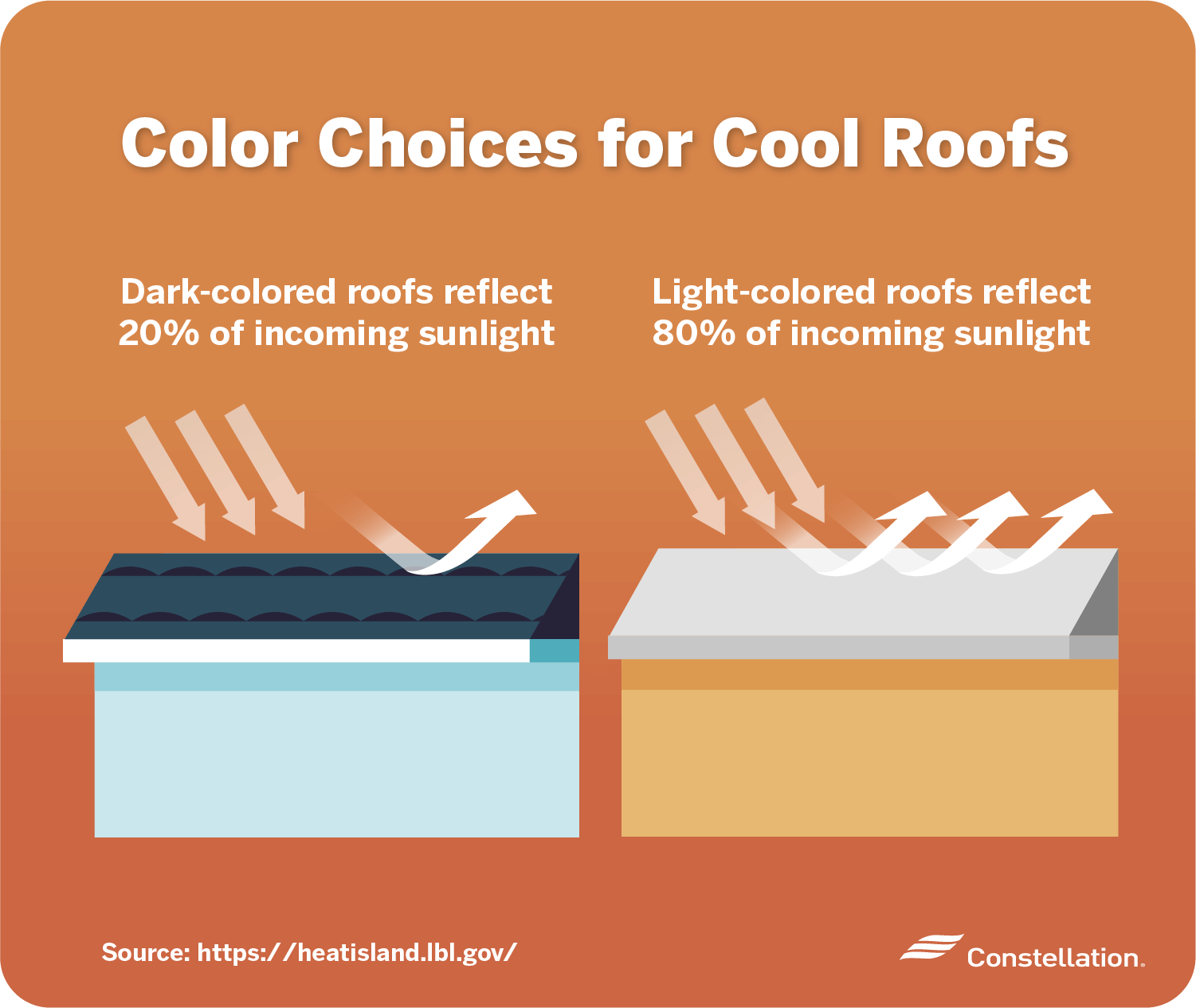
2. Cool roofing materials for flat or low-sloped roofs
While a flat roof has no gradation, a low-sloped roof is generally defined as a roof that rises at an angle of less than 18.5 degrees. If you have a small business, it’s likely that you have a flat or low-sloped roof. To find out the slope of your roof, you can contact a professional for accurate estimates and measurements.
Cool roof solutions for flat or low-sloped roofs often come in a variety of materials to reflect thermal heat, providing flexible solutions for you and your small business.
Cool roof coatings
Cool coatings are one of the easiest cool roofing solutions available for low-slope roofs. While there are benefits to painting your roof white to save energy, applying a cool roof coating provides even better results. These coatings, which resemble thick paint, protect the roof from ultraviolet damage while increasing reflectivity. Some also provide water protection.
Single-ply membranes for cool roofs
Single-ply membranes are prefabricated sheets rolled into place on the roof and attached by mechanical means or chemical adhesives. Generally a more expensive cooling solution than coatings, single-ply membranes are sturdier and provide additional protection to the underlying roof.
Single-ply membranes come in two categories:
- Single-ply thermoset membranes are sealed together with tape or contact cement.
- Single-ply thermoplastics form a seamless surface after the installer applies heat to the membrane’s edges.
3. Cool roofing materials for high-sloped roofs
High-sloped roofs generally have a gradation steeper than 18.5 degrees. Because of their slope, it can be difficult to apply some types of heat reflective roofs to their surfaces. Reflective coatings, for instance, are difficult to apply evenly. A professional will be able to determine the slope of your roof and what cool roofing system will work best.
Some single-ply membranes may be installed on high-sloped roofs, but the most effective solutions for high-sloped roofs are cool roof shingles and tiles.
Cool roof shingles and tiles
Cool roof shingles and tiles are infused with special granules to give them better solar reflectance. The heavy mass of cool roof shingles and tiles can also provide some level of thermal protection. To do this, they absorb and block heat during the day, then release heat throughout the night.
Metal shingles or tiles are also a worthy option for high-sloped roofs, along with several other types of energy-efficient roof shingles.
How the Constellation headquarters utilizes cool roofing to combat climate change
Flat- or low-sloped cool roofs can also be used with green roofing systems to help save energy and promote sustainability. That’s why Constellation’s headquarters uses a flat cool roof, in combination with green roofing, to create an energy-efficient solution that decreases both energy use and greenhouse gas emissions.
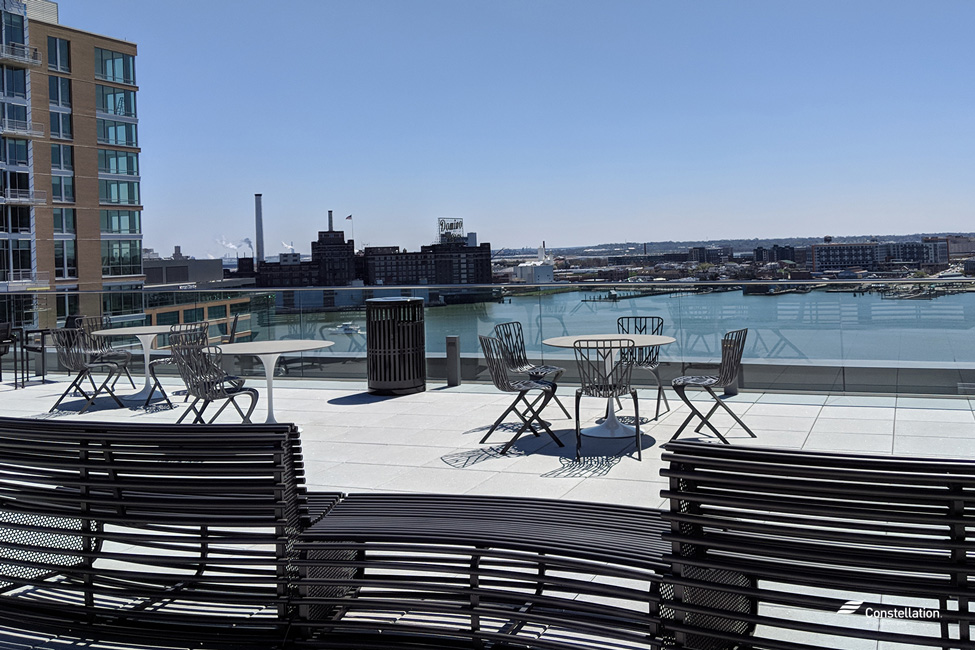
Constellation’s cool roofing system has even helped the building earn an overall LEED Gold designation, while the interior was awarded LEED Platinum status. The US Green Building Council awards LEED (Leadership in Energy and Environmental Design) certification to cost-efficient, sustainable buildings based on a strict set of criteria.
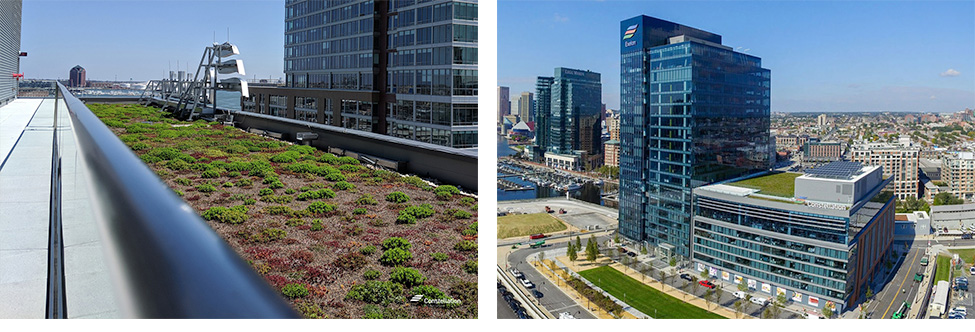
Are cool roofs worth it for small businesses?
If you’re still undecided as to whether a cool roof is worth the investment, keep in mind that making energy-efficient improvements to your roof may qualify you for small business energy tax credits. These incentives allow you to recoup a portion of the expense associated with transitioning to an energy-efficient workplace.
Painting the roof white or implementing any type of cool roof is just one of the steps small businesses can make to conserve energy. There are various other ways to engage your customers in sustainability and run a more environmentally-friendly business.




